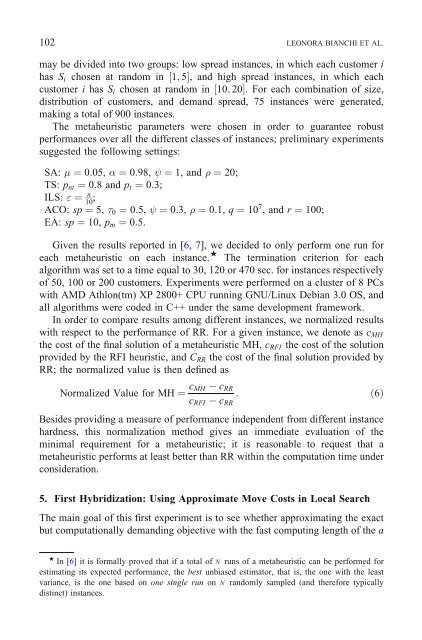Hybrid Metaheuristics for the Vehicle Routing Problem with ...
Hybrid Metaheuristics for the Vehicle Routing Problem with ...
Hybrid Metaheuristics for the Vehicle Routing Problem with ...
Create successful ePaper yourself
Turn your PDF publications into a flip-book with our unique Google optimized e-Paper software.
102 LEONORA BIANCHI ET AL.<br />
may be divided into two groups: low spread instances, in which each customer i<br />
has Si chosen at random in ½1; 5Š, and high spread instances, in which each<br />
customer i has Si chosen at random in ½10; 20Š. For each combination of size,<br />
distribution of customers, and demand spread, 75 instances were generated,<br />
making a total of 900 instances.<br />
The metaheuristic parameters were chosen in order to guarantee robust<br />
per<strong>for</strong>mances over all <strong>the</strong> different classes of instances; preliminary experiments<br />
suggested <strong>the</strong> following settings:<br />
SA: ¼ 0:05, ¼ 0:98, ¼ 1, and ¼ 20;<br />
TS: pnt ¼ 0:8 and pt ¼ 0:3;<br />
ILS: " ¼ n<br />
10 ;<br />
ACO: sp ¼ 5, 0 ¼ 0:5, ¼ 0:3, ¼ 0:1, q ¼ 107 , and r ¼ 100;<br />
EA: sp ¼ 10, pm ¼ 0:5.<br />
Given <strong>the</strong> results reported in [6, 7], we decided to only per<strong>for</strong>m one run <strong>for</strong><br />
each metaheuristic on each instance. j The termination criterion <strong>for</strong> each<br />
algorithm was set to a time equal to 30, 120 or 470 sec. <strong>for</strong> instances respectively<br />
of 50, 100 or 200 customers. Experiments were per<strong>for</strong>med on a cluster of 8 PCs<br />
<strong>with</strong> AMD Athlon(tm) XP 2800+ CPU running GNU/Linux Debian 3.0 OS, and<br />
all algorithms were coded in C++ under <strong>the</strong> same development framework.<br />
In order to compare results among different instances, we normalized results<br />
<strong>with</strong> respect to <strong>the</strong> per<strong>for</strong>mance of RR. For a given instance, we denote as cMH<br />
<strong>the</strong> cost of <strong>the</strong> final solution of a metaheuristic MH, cRFI <strong>the</strong> cost of <strong>the</strong> solution<br />
provided by <strong>the</strong> RFI heuristic, and CRR <strong>the</strong> cost of <strong>the</strong> final solution provided by<br />
RR; <strong>the</strong> normalized value is <strong>the</strong>n defined as<br />
Normalized Value <strong>for</strong> MH ¼ cMH cRR<br />
: ð6Þ<br />
cRFI cRR<br />
Besides providing a measure of per<strong>for</strong>mance independent from different instance<br />
hardness, this normalization method gives an immediate evaluation of <strong>the</strong><br />
minimal requirement <strong>for</strong> a metaheuristic; it is reasonable to request that a<br />
metaheuristic per<strong>for</strong>ms at least better than RR <strong>with</strong>in <strong>the</strong> computation time under<br />
consideration.<br />
5. First <strong>Hybrid</strong>ization: Using Approximate Move Costs in Local Search<br />
The main goal of this first experiment is to see whe<strong>the</strong>r approximating <strong>the</strong> exact<br />
but computationally demanding objective <strong>with</strong> <strong>the</strong> fast computing length of <strong>the</strong> a<br />
j In [6] it is <strong>for</strong>mally proved that if a total of N runs of a metaheuristic can be per<strong>for</strong>med <strong>for</strong><br />
estimating its expected per<strong>for</strong>mance, <strong>the</strong> best unbiased estimator, that is, <strong>the</strong> one <strong>with</strong> <strong>the</strong> least<br />
variance, is <strong>the</strong> one based on one single run on N randomly sampled (and <strong>the</strong>re<strong>for</strong>e typically<br />
distinct) instances.
















